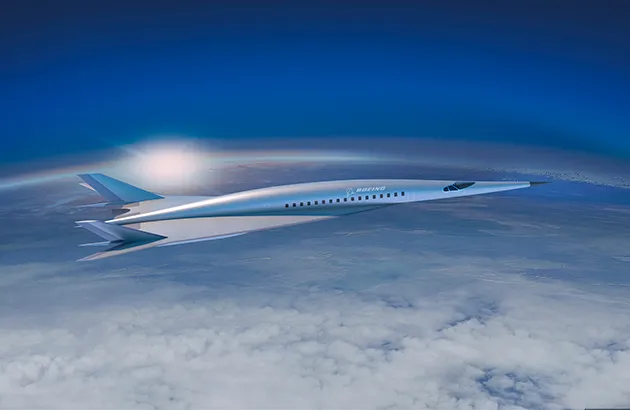
Boeing's passenger plans go hypersonic.
Jun 27, 2018

Boeing is actively pursuing the development of hypersonic passenger aircraft, aiming to revolutionize air travel by significantly reducing flight times. These aircraft are designed to travel at speeds exceeding five times the speed of sound, potentially allowing passengers to fly from New York to London in under an hour. Boeing's initiative focuses on advanced technologies and innovative designs to ensure safety and efficiency while addressing environmental concerns. Collaborations with various aerospace partners and government agencies are underway to research and develop the necessary infrastructure and regulatory frameworks, paving the way for a new era in commercial aviation.
Boeing has been at the forefront of aerospace innovation for decades, and its latest venture into "hypersonic passenger travel" is a testament to its commitment to redefining air travel. As the demand for faster and more efficient travel grows, Boeing's plans to develop hypersonic passenger planes could revolutionize the aviation industry. This article delves into Boeing's hypersonic ambitions, the technology involved, and what it means for the future of air travel.
The Need for Speed in Air Travel
In today's fast-paced world, passengers are seeking shorter travel times without compromising comfort and safety. Traditional subsonic aircraft can take hours to cross continents, which has led to a growing interest in "hypersonic travel"—defined as travel at speeds greater than Mach 5, or five times the speed of sound. Boeing's interest in this technology is driven by the potential to cut travel times significantly, allowing passengers to fly from New York to London in under two hours.
Boeing's Hypersonic Technology
Boeing's hypersonic aircraft development involves advanced materials and innovative engineering. The following table summarizes some key technologies that Boeing is exploring:
| Technology | Description |
|---|---|
| Scramjet Engines | Utilize supersonic combustion to achieve high speeds with improved efficiency. |
| Advanced Materials | Developing heat-resistant materials to withstand extreme temperatures during hypersonic flight. |
| Autonomous Systems | Implementing AI-driven systems to enhance flight safety and efficiency. |
These technologies are vital for ensuring that Boeing's hypersonic passenger planes can operate safely and effectively. The company is also collaborating with various partners, including government agencies and research institutions, to accelerate the development of this cutting-edge technology.
The Benefits of Hypersonic Travel
There are several notable advantages to hypersonic travel that could transform the passenger experience:
- Reduced Travel Times: Passengers could travel from major cities around the globe in mere hours, drastically reducing the inconvenience of long-haul flights.
- Enhanced Connectivity: Hypersonic travel could open up new routes and make remote destinations more accessible.
- Economic Growth: Faster travel could boost international business and tourism, leading to increased economic opportunities.
Challenges Ahead
While the prospect of "hypersonic passenger planes" is exciting, there are significant challenges that Boeing must overcome:
- Regulatory Hurdles: The aviation industry is heavily regulated, and Boeing will need to navigate complex regulatory frameworks to gain approval for hypersonic travel.
- Cost of Development: The investment required for research, development, and testing of new technologies is substantial, and Boeing must ensure that the potential market justifies this expense.
- Environmental Concerns: Hypersonic travel may have environmental implications, including increased noise levels and greenhouse gas emissions, which need to be addressed.
The Future of Hypersonic Travel
Boeing's commitment to hypersonic passenger travel is clear, and the company is positioning itself to become a leader in this emerging market. As advancements in technology continue to evolve, the dream of hypersonic commercial flights may soon become a reality.
With a focus on safety, efficiency, and passenger comfort, Boeing's hypersonic plans could not only change the way we travel but also redefine our expectations of what is possible in aviation. As these developments unfold, travelers and industry stakeholders alike will be watching closely to see how Boeing navigates the challenges and opportunities that lie ahead.
Conclusion
The future of air travel is bright, and Boeing's exploration of "hypersonic passenger planes" represents a pivotal moment in the aviation industry. With the potential to drastically reduce travel times while enhancing the overall passenger experience, hypersonic travel could be the next frontier in commercial aviation. As Boeing continues its journey into this innovative realm, it remains to be seen how quickly we can expect to see hypersonic flights take to the skies.
In summary, Boeing's passenger plans going hypersonic is not just a technological leap; it reflects the evolving needs of modern travelers and the industry's response to those demands. The combination of cutting-edge technology, strategic partnerships, and a focus on passenger experience places Boeing at the forefront of a new era in aviation.
Related Articles

Explore Thailand: The Best Islands to Visit for Paradise, Adventure, and Relaxation

The Ultimate Guide to the Best Islands in Thailand for Your Next Getaway

Do babies need passports? How to get a passport for a newborn

How to get a U.S. passport fast: here’s how to expedite the process

What is Mobile Passport Control: 5 reasons why you should use it

SENTRI vs. Global Entry: A detailed guide

Do you need a passport to go to the Bahamas? Let’s find out

Do you need a passport to go to Mexico? A detailed guide

Do you need a passport to go to Canada? We got the answer

Do You Need a Passport for a Cruise: An Essential Travel Guide

Booster Seat Requirements: All the Rules to Follow in Your Rental Car

What Are the World’s Most Powerful Passports, and How Does Yours Rank?

How to Take a Passport Photo at Home: A Helpful Guide

You've got to have heart! Southwest's new livery

Your opinion: Should water be free on low cost carriers?

Young women bolder than guys as solo travellers
